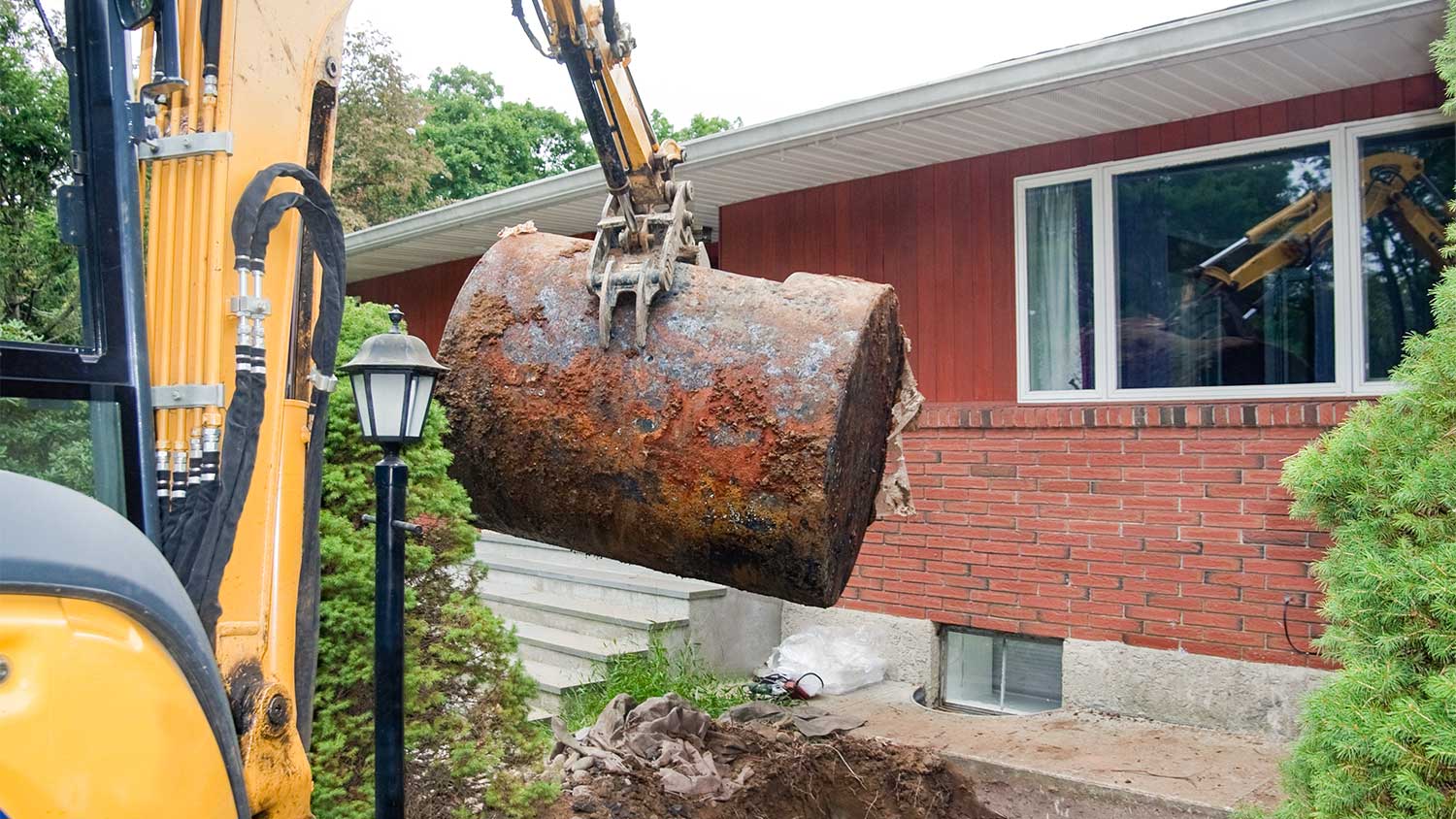
Mattresses are considered hazardous waste, so you’ll likely have to pay disposal fees. Use this guide on mattress removal costs to see what your total will be.
The average oil tank removal cost is $1,357, with most homeowners paying between $592 and $2,157, depending on tank type, size, and site conditions.


Key oil tank removal cost factors include tank location, size, construction material, and local permit or remediation requirements.
Professional removal costs $50 to $150 per hour and ensures compliance with local regulations, and minimizes hazards from leaks or spills.
Soil testing and remediation are sometimes necessary, costing $100 to $300 per test.
Aboveground tanks are the most affordable to remove at $400 to $1,000, while underground tank removal ranges from $1,500 to $3,000.
This article was created using automation technology and thoroughly fact-checked and edited by an Angi Editor in accordance with our AI policy.
Oil tank removal cost averages $1,357, with an average range from $592 to $2,157. Factors like tank type, size, and site accessibility affect the final price. Homeowners may also pay per gallon or per square foot for larger or more complex projects. Understanding these costs helps you plan and budget effectively.
Removing an oil tank is important for safety, property value, and legal compliance. This guide explains every cost factor so you know what to expect and how to make the best decision for your home.
Let’s break down what impacts your oil tank removal cost. Tank type, size, material, and the condition of your property all affect the final price.

The type of oil tank you have—aboveground or underground—has a major impact on removal cost. Aboveground tanks are generally easier and cheaper to remove, as they’re accessible and do not require excavation. Underground tanks, on the other hand, require digging, soil testing, and carry added environmental risks, which increase both labor and disposal fees.
Steel and fiberglass are the most common tank materials. Specialty tanks, such as those built into basements or with reinforced concrete, may require extra steps, raising costs. The removal process for underground tanks also often includes additional local regulations and safety measures.
| Tank Type | Average Cost |
|---|---|
| Aboveground | $400–$1,000 |
| Underground | $1,500–$3,000 |
| Specialty tanks | $2,000–$7,000 |
The size of your oil tank, measured in gallons or dimensions, directly affects your oil tank removal cost. Common residential sizes include 275, 500, and 1,000 gallons. Larger tanks require more labor, may need heavier equipment, and often come with higher disposal fees.
| Tank Size (Gallons) | Average Cost |
|---|---|
| 275 | $800–$1,200 |
| 500 | $1,200–$1,800 |
| 1,000 | $1,300–$2,000+ |
Tank construction material also affects your oil tank removal cost. Steel tanks are the most common and are relatively straightforward to dismantle, but may carry higher disposal fees if rusted or contaminated. Fiberglass tanks are lighter and less prone to corrosion, which can lower labor costs but may have separate disposal requirements. Composite or reinforced tanks sometimes involve hazardous materials, which can increase both removal and disposal costs.
| Material Type | Average Cost |
|---|---|
| Steel | $200–$600 |
| Fiberglass | $150–$400 |
| Composite | $300–$800+ |
Labor is a significant component of your oil tank removal cost. Environmental contractors, general contractors, and hazardous material specialists may all be involved. Labor is often charged as a flat fee for small tanks or hourly for larger or more complex jobs. Expect to pay between $50 and $150 per hour, with higher rates in urban or high-demand regions.
Tank accessibility also matters—tanks under decks, driveways, or tight spaces will raise labor costs. If the site requires special equipment or safety procedures, the price increases as well.
Site preparation includes clearing access to the tank, disconnecting fuel lines, and draining any remaining oil. Soil testing and sampling are often required before removal, especially for underground tanks. Permitting and inspection fees are also part of prep, with permits costing $50 to $500, depending on your municipality.
Average prep costs range from $200 to $1,000, depending on the complexity and local requirements.
Tipping oil tank removal crews is not an industry standard, but it is appreciated for exceptional service, especially on difficult jobs. If you wish to tip, $20 to $50 per worker is a reasonable amount. Alternatively, providing refreshments or a positive review is a thoughtful gesture.
Additional factors can increase your oil tank removal cost:
Demolition of structures or concrete over the tank, which may require extra equipment and labor.
Post-removal site restoration, such as backfilling, grading, or landscaping, to return your yard to its original state.
Soil remediation, if contamination is found, often costs $50 to $200 per cubic yard.
Hauling and disposal of residual oil and tank debris, sometimes charged per gallon or as a flat fee.
Removal of associated piping, vent lines, or monitoring wells, which can add $200 to $800 to your bill.
Decorative or functional add-ons, such as new landscaping or hardscaping, after removal.
Once your oil tank is gone, most ongoing costs disappear, but there are a few exceptions to keep in mind.
If you replace your oil tank with a new one, ongoing maintenance applies. After removal, you may need to monitor the site for residual contamination or settling. Some local regulations require periodic soil testing, which can cost $100 to $300 per test.
There are no direct operating costs after oil tank removal. However, if you switch to a new heating system, you may have new fuel or utility costs. For example, converting to natural gas or electric heat can change your monthly expenses. Be sure to factor in these changes when budgeting for your project.
After oil tank removal, common repairs include fixing landscaping, driveways, or structures disturbed during the process. Repairing minor leaks or damage discovered during removal can cost $200 to $2,000, depending on severity. If the foundation or utility lines are impacted, repairs may add significantly to your total cost.
Removing an oil tank can lower your insurance premiums by reducing environmental liability. You may need to provide proof of removal to your insurance company. Environmental liability insurance during or after removal is sometimes required by lenders or local regulations, with premiums ranging from $200 to $1,000 per year.

You may wonder if you can save on oil tank removal costs by doing it yourself. Let’s compare both options.
DIY removal involves expenses for equipment rental, disposal fees, permits, and safety gear—often totaling $500 to $1,500 or more. While you can save on labor, you risk fines, environmental hazards, and improper removal if you lack experience. Most states require certified professionals for underground or large tank removal due to safety and environmental regulations.
The process is physically demanding and time-consuming, often taking several days. Improper removal can lead to penalties, environmental damage, or legal liability. In many areas, hiring a professional is required by law for underground tanks, and it’s always recommended for safety and peace of mind.
Several add-ons can affect your final oil tank removal cost:
Soil testing and analysis: $50 to $200 per sample, or $300 to $1,000 per project
Soil remediation: $50 to $200 per cubic yard, or $1,000 to $10,000 per project, depending on contamination
Backfilling and grading: $5 to $15 per square foot, depending on material and site conditions
Landscaping restoration: $500 to $3,000 for sod, seeding, or plant replacement
Removal of associated piping, vent lines, or monitoring wells: $200 to $800
Disposal of residual oil: $2 to $5 per gallon, or a flat fee of $100 to $500
There are several ways you can lower your oil tank removal cost:
Get multiple quotes from licensed local oil tank removal contractors to compare pricing and services.
Schedule removal during off-peak seasons, when contractors may offer discounts.
Prepare the site in advance by clearing access or removing obstructions to reduce labor time.
Bundle oil tank removal with other home improvement projects, such as landscaping or driveway work, for potential savings.
Check for local or state grants, rebates, or assistance programs that can offset costs.
Ensure proper documentation to avoid future legal or insurance issues, preventing costly complications down the road.
Home is the most important place on earth, which is why Angi has helped more than 150 million homeowners transform their houses into homes they adore. To help homeowners with their next project, Angi provides readers with the most accurate cost data and upholds strict editorial standards. We extensively research project costs to develop the pricing data you see, so you can make the best decisions for you and your home. We rely on reputable sources, including the U.S. Bureau of Labor Statistics, academic journals, market studies, and interviews with industry experts—all to ensure our prices reflect real-world projects.
Want to help us improve our cost data? Send us a recent project quote to [email protected]. Quotes and personal information will not be shared publicly.
From average costs to expert advice, get all the answers you need to get your job done.

Mattresses are considered hazardous waste, so you’ll likely have to pay disposal fees. Use this guide on mattress removal costs to see what your total will be.

Need to get rid of paint, solvents, or other chemicals? Use this guide on hazardous waste disposal costs to see what professional removal will cost.

Used stain rags can be flammable and pose safety risks. Learn how to dispose of stain rags safely and responsibly.

Ripped up old laminate floors for your dream home, or installing new ones? Learn how to dispose of laminate flooring if you have more than you need.

Old carpeting can be an environmental hazard, so it’s important to know how to dispose of carpet safely and responsibly. Learn more with this guide.

Fire extinguishers don’t last forever, but you can’t just throw them in the trash. Learn how to dispose of a fire extinguisher safely and correctly.